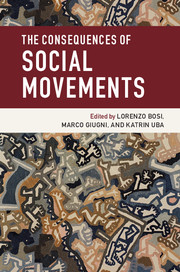Book contents
- Frontmatter
- Contents
- List of figures
- List of tables
- List of contributors
- Introduction
- Part I People
- Part II Policies
- 7 Protest against school closures in Sweden: accepted by politicians?
- 8 Feminist mobilization and the politics of rights
- 9 Reputation, risk, and anti-corporate activism: how social movements influence corporate outcomes
- 10 Tactical competition and movement outcomes on markets: the rise of ethical fashion
- Part III Institutions
- Conclusion
- Index
- References
8 - Feminist mobilization and the politics of rights
from Part II - Policies
Published online by Cambridge University Press: 05 January 2016
- Frontmatter
- Contents
- List of figures
- List of tables
- List of contributors
- Introduction
- Part I People
- Part II Policies
- 7 Protest against school closures in Sweden: accepted by politicians?
- 8 Feminist mobilization and the politics of rights
- 9 Reputation, risk, and anti-corporate activism: how social movements influence corporate outcomes
- 10 Tactical competition and movement outcomes on markets: the rise of ethical fashion
- Part III Institutions
- Conclusion
- Index
- References
Summary
On Sunday, March 7, 1965, hundreds of civil rights marchers crossed the Edmund Pettus Bridge on the outskirts of Selma, Alabama, headed for the state capitol in Montgomery. On the other side, state and local police descended on them with tear gas and billy clubs. National news captured shocking images of law enforcement officers beating nonviolent demonstrators who were seeking only the basic element of political freedom: the right to vote. The broadcast of media footage of the melee provoked national and international outrage. This violent episode in Selma, an event that came to be known as “Bloody Sunday,” proved to be a decisive catalyst for federal action on voting rights. During the Selma protests, over a hundred members of the House and Senate rose in their respective chambers to denounce lawlessness and the deprivation of fundamental rights (Garrow 1978). Only a week after Bloody Sunday, citing the events in Selma, President Lyndon Johnson announced his intention to submit sweeping voting rights legislation. Although southern Democrats filibustered the bill in the Senate, a bipartisan coalition swept aside their opposition and, five months later, enacted into law the Voting Rights Act of 1965. Because of these events, multiple studies of the civil rights movement document the association between protests, white violence, and government responsiveness to movement demands (Burstein 1979; Garrow 1978; McAdam 1982). Yet, in some ways, this extraordinary movement triumph encourages a faulty impression of how movements achieve political change because incidents such as this, and the public attention they garner, are extraordinarily rare. The far more common setting for social movements is one of broad public disinterest and inattention.
Accordingly, research on the impact of social movements on public policy outcomes presents a much more mixed picture. In their extensive literature review of this topic, Andrews and Edwards (2004) find that, “[advocacy organizations exert] a modest role at best on congressional voting patterns.” Casting doubt on the efficacy of protests, Burstein and Sausner (2005) suggest that, given the infrequency of such events, even among the most active movements, it is hardly surprising that evidence for movement impact is uneven. It is implausible, they argue, that congressional majorities would feel impelled to respond to the demands of benefit-seekers active in relatively few localities and engaging in a small number of protests. Nevertheless, others find that movement mobilization does affect government responsiveness and policy outcomes (Amenta 2006).
- Type
- Chapter
- Information
- The Consequences of Social Movements , pp. 185 - 214Publisher: Cambridge University PressPrint publication year: 2016
References
- 6
- Cited by



